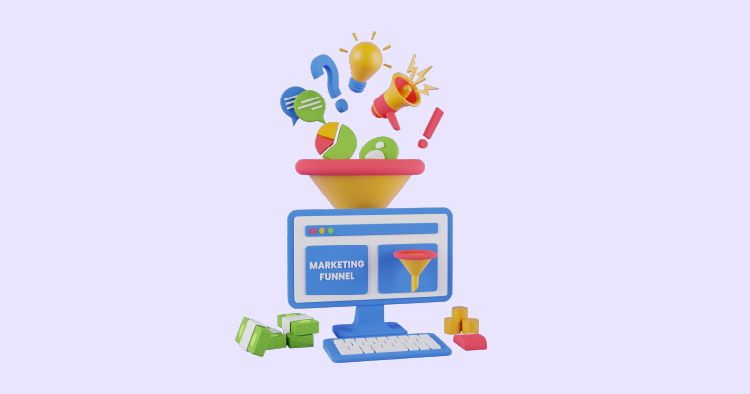Creating a sales funnel on your website can significantly enhance your online business’s ability to convert visitors into loyal customers. An effective sales funnel is not just a marketing tool; it’s a structured approach to guiding potential customers through the buying process. From capturing the initial attention of your audience to nurturing leads and closing sales, each step of the funnel serves a specific purpose. In this guide, we’ll explore the critical components of a successful sales funnel and provide actionable insights on implementing them on your website. Understanding and optimizing each stage can improve conversion rates and drive business growth.
Understanding the Sales Funnel
A sales funnel is like a roadmap of a customer’s journey with your business, from when they first hear about you to when they purchase. Think of it as a series of steps, beginning with awareness (when someone learns about your product or service), followed by interest (when they think it might be helpful), decision (when they’re considering a purchase), and finally, action (when they buy).
Applying this concept to your website helps you organize your content and pages in a way that naturally leads visitors through these stages. A well-planned sales funnel on your site makes it easier for people to learn about what you offer, understand why it’s right for them, and decide to buy, which means more customers for you. Plus, by watching how people move through your funnel, you can improve it and boost your sales.
Identifying Your Target Audience
Knowing who you’re selling to is a big deal for any business, especially when building a sales funnel website. When you have a clear picture of your ideal customer—their likes, needs, and the problems they’re trying to solve—you can craft your sales funnel to address them. This makes your website more engaging and can lead to more sales.
To determine your target audience, you can send surveys, observe how people behave online, and listen to what they say about products or services like yours. This information helps you build a sales funnel that feels personal to your potential customers, making them more likely to trust you and eventually buy from you.
Creating a Compelling Lead Magnet
A lead magnet is a powerful tool for attracting potential customers to your sales funnel website. Think of it as a trade-off: you offer something valuable, like a free ebook, webinar, or trial, and in exchange, visitors give you their contact information. It’s a win-win. The visitor gets helpful with something, and you can turn them into a lead.
Knowing what your audience wants is crucial to creating a lead magnet that works. What problems do they have? What kind of information are they searching for? Your lead magnet should be the answer they’re looking for. It should pack valuable insights or solutions directly aligned with your audience’s concerns.
Designing an Eye-Catching Landing Page
Your landing page is where the magic happens—it’s the first thing visitors see after they click on your ad or a promotional link. This page has to grab their attention and make them want to stay. An excellent landing page can mean the difference between someone just passing through and someone ready to take the next step in your sales funnel.
Struggling with Digital marketing? Book Your Free Strategy Session!
- 30-Minutes Session
- Expert Insights
- Data-Driven approach
- Optimized Strategies for Your Goals
To design a landing page that converts visitors into leads, start with a headline that’s impossible to ignore. It should be clear and engaging and speak directly to what your audience is looking for. The content should be concise, convincing, and paired with pop visuals. Navigation should be a breeze, with a standout call-to-action that leaves no doubt about what to do next. And, of course, the overall design should reflect your brand and meet your audience’s expectations. By focusing on these elements, you can create a landing page that looks good and works hard to convert visitors into leads.
Creating an Irresistible Call-to-Action (CTA)
A call to action (CTA) is like a signpost on your website telling visitors what to do next. It can guide them to grab a free ebook, sign up for updates, or buy your product. A good CTA can make a difference in convincing someone to take that next step.
When you come across CTAs like “Download Your Free Guide Today,” “Get Started Now,” or “Join Our Exclusive Community,” they’re designed to get you moving. They use words that push you to act and often create a feeling that you should act quickly or that you’re getting into something special.
Implementing Opt-In Forms for Lead Generation
Opt-in forms are like nets for catching potential leads on your website. They can pop up on the screen, sit quietly in the corner, or be part of your reading article. Where you put these forms can affect their effectiveness, so it’s wise to try different spots to see what works best.
To make these forms work for you, keep them simple, write something catchy, and offer a little gift for someone’s contact info. Also, ensuring they look good on phones and do not annoy your visitors by getting in the way is super important.
Nurturing Leads with Email Marketing
Email marketing is essential for keeping potential customers interested after they’ve shown interest in your product or service. When someone signs up to hear from you, that’s your chance to keep the conversation going with emails that offer them something of value. This could be helpful information, exciting updates, or special deals that are hard to resist.
To ensure your emails are effective, try adding a personal touch, like using the recipient’s name or tailoring content to their interests. Breaking up your email list into different groups (or segments) lets you send more targeted messages. And always focus on giving your readers something valuable—whether it’s tips, insights, or news they can use.
Design your emails to not only catch the eye but also to provide natural substance. This way, you’re not just selling but building a relationship. Each email should help move the reader closer to deciding, ideally leading them to choose your product or service.
Leveraging Social Proof to Build Trust
They often look to others for guidance when deciding whether to buy from you. That’s where social proof comes in. It’s all about showing potential customers that others have had a great experience with your offering. This can make a tremendous difference in convincing someone to take the next step.
Struggling with Digital marketing? Book Your Free Strategy Session!
- 30-Minutes Session
- Expert Insights
- Data-Driven approach
- Optimized Strategies for Your Goals
You can use social proof. Share stories from customers who love your product, post reviews that rave about your service, or even highlight a thumbs-up from a celebrity or expert. The key is to show that real people, like those visiting your site, are happy they chose you.
To effectively weave social proof into your sales funnel, consider putting customer quotes on your main page so they’re one of the first things visitors see. You can also place glowing reviews that are easy to find, like next to the buttons where people sign up or purchase. And when discussing your product, don’t forget to mention big names who’ve approved you. These strategies can help tip the scales and turn browsers into buyers.
Upselling and Cross-Selling Strategies
Upselling and cross-selling are techniques businesses use to encourage customers to spend more. They guide customers towards higher-end products or additional items that complement their initial purchase. These approaches can create a win-win situation: customers get more value, and businesses increase their sales.
To effectively upsell, you might show customers a luxury version of an item they’re considering. For example, imagine someone looking at a basic smartphone model. You might highlight the benefits of a version with more features or better performance, explaining how it could be a worthwhile investment.
Cross-selling involves suggesting products that complement the customer’s existing interests. For example, if a customer buys a new camera, you could recommend a protective case or an extra memory card. The key is ensuring these suggestions are genuinely helpful and relevant to the customer’s needs.
Creating package deals or bundles is another intelligent tactic. You can group products that naturally complement each other at a slightly reduced price compared to buying them separately. This not only adds convenience for the customer but also increases the business’s sales.
Streamlining the Checkout Process
A smooth checkout process keeps customers happy and willing to complete their purchases. If the process is too complex or takes too long, people might give up and leave without buying anything.
To make the checkout as painless as possible, start by cutting down on the number of steps. Ask only for essential information and consider auto-filling details where appropriate. Also, it offers a variety of payment methods to cater to different preferences, whether it’s credit card, PayPal, or newer options like mobile payments.
Another must be making sure your checkout works well on smartphones and tablets. A mobile-friendly experience can make a big difference as more people shop on their devices.
For those who want a quick transaction, provide a guest checkout option. Not everyone wants to create an account, especially if they’re in a hurry or it’s their first time shopping with you.
Lastly, make sure customers feel secure. Display security badges and use encryption to protect their information. If people trust their data is safe, they’re more likely to purchase.
Analyzing and Optimizing Your Sales Funnel
Understanding how your sales funnel is performing is critical to making it more effective. You want to look at essential numbers like the number of people moving through each stage of the funnel (conversion rates), the number leaving your site after only viewing one page (bounce rates), and the cost of acquiring a new customer (customer acquisition costs). These numbers give you a clear picture of what’s working and what’s not.
To improve your sales funnel, keep a close eye on these numbers. Look for places where customers seem to lose interest and leave. Once you find these spots, try different strategies to keep them engaged. This might mean making your content more engaging, making your website easier to navigate, or changing your offers and calls to action to be more appealing.
Integrating Sales Funnel Tools and Software
Using the right tools can make managing your sales funnel much easier. These tools can handle repetitive tasks, help you track leads, send marketing messages at the right time, and provide valuable data to make intelligent choices.
For those running smaller businesses, several sales funnel and website builders are popular because they’re easy to use and can be tailored to fit your needs. ClickFunnels, Leadpages, and Unbounce are some of these platforms. These platforms offer templates you can customize to align with your brand and connect them with other marketing tools to create a seamless sales process.
Driving Traffic to Your Sales Funnel
Getting more people to visit your sales funnel website is critical to making more sales and getting more leads. You can use different methods to increase traffic, like SEO, content marketing, social media, and paid ads. Each has benefits; you can mix them to get the best results.
SEO makes your website more attractive to search engines, so it shows higher in search results. Content marketing is about creating valuable, engaging content that draws people in and keeps them engaged. Social media marketing uses platforms like Facebook and Twitter to connect with people and share your content. Paid advertising is a fast way to get your message in front of a specific group of people.
Measuring Success and ROI
To know if your sales funnel works well, you need to look at how many sales you’re making, how much each customer is worth over time, and how many new leads you’re getting. These numbers give you a clear picture of how well your funnel is doing and what you might need to change to improve it.
Figuring out your ROI, or return on investment, means comparing the money you make from your funnel to the amount you spent to create and run it. This includes the cost of tools, ads, and any other resources you’ve used. Knowing your ROI is important because it tells you where to spend your money to get the most out of your sales funnel.
Final Thoughts
In the digital marketplace, it’s impossible to overstate the power of an optimized sales funnel. Refining each step from awareness to action creates a seamless journey for your customers. Monitoring and tweaking your funnel is an ongoing process that can lead to increased engagement and higher conversion rates. Remember that the most successful sales funnels are customer-centric, offering value at every stage. Implement these strategies on your website, and watch as your business transforms prospects into repeat buyers, fostering long-term success.



